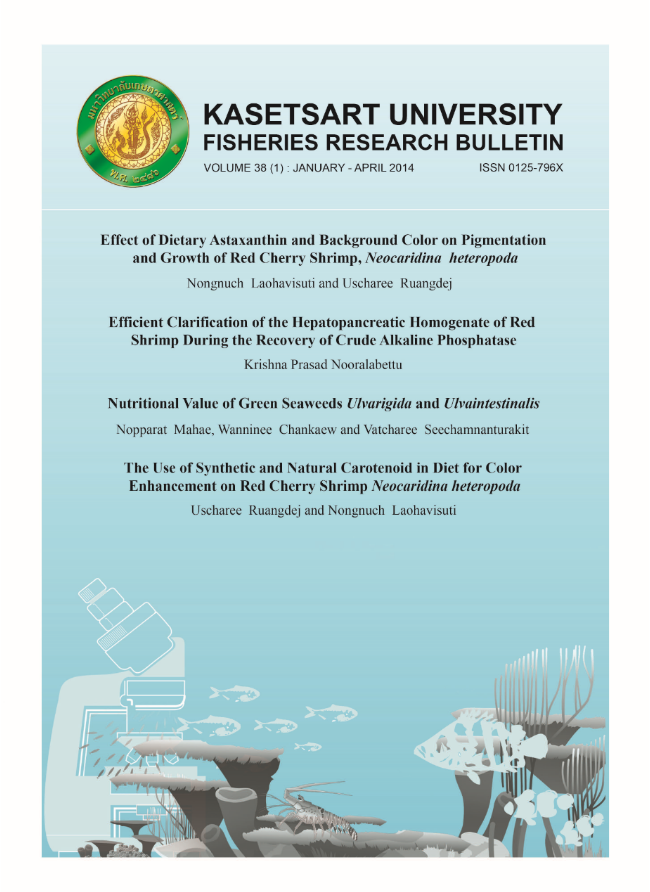The Use of Synthetic and Natural Carotenoid in Diet for Color Enhancement on Red Cherry Shrimp Neocaridina heteropoda
Main Article Content
Abstract
Color enhancement of red cherry shrimp, Neocaridina heteropoda, was studied in 2 experiments in order to evaluate the feasibility of including different sources of carotenoid in shrimp diet. In the first experiment, 3 concentrations (0, 80 and160 mg.kg-1 of synthetic carotenoid diet were tested. Shrimp were fed twice a day. After 8 weeks, shrimp fed with160 mg.kg-1 showed more significant coloration improvement than those fed with lower carotenoid diets. This shows that the color of red cherry shrimp could be enhanced by incorporating carotenoid into their diet. The second experiment aimed to reduce cost by using a cheap available source of natural carotenoid, i.e. marigold petal, at rates of 0, 50, 100 and 200 mg.kg-1 diet. Results showed that the reddish color of shrimp fed with the natural carotenoid source at 200 mg.kg-1 were most enhanced compared with the other groups, including obtaining the highest survival rate (99%). Carotenoid content analysis from whole shrimp revealed that increasing dietary carotenoid concentration resulted in a significant increase in total carotenoid concentration. It is concluded that natural color enhancer diets for red cherry shrimp can be prepared using carotenoid from marigold petals at 200 mg.kg-1.
Article Details
References
2. Chien, Y. and S. Jeng. 1992. Pigmentation of kuruma prawn, Penaeus japonicus Bate, by various pigment sources and levels and feeding regimes. Aquaculture 102: 333-346.
3. Ingle de laMora, G., J. L. Arredondo- Figueroa, J. T. Ponce-Palafox, I. delos Angeles Barriga-Soca and J. E. Vernon-Carter.2006. Comparison of red chilli (Capsocum annuum) oleoresin and astaxanthin on rainbow trout (Oncorhyncus mykiss) fillet pigmentation. Aquaculture 258: 487-495.
4. Latscha,T. 1991. Carotenoids in aquatic animal nutrition. In: Proceedings of the aquaculture feed processing and nutrition workshop (Akiyuma, D. M. & Tan, R. K., eds), pp. 68-69. Thailand and Indonesia.
5. Stahl, W. and H. Sies. 2005. Bioactivity and protective effects of natural carotenoids. Biochimica et Biophysica Acta 1740: 101-107.
6. Supamattaya, K., S. Kiriratnikom, M. Boonyaratpalin and L. Borowitzka. 2005. Effect of Dunaliella extract on growth performance, health condition, immune response and disease resistance in black tiger shrimp (Penaeus monodon). Aquaculture 248: 207-216.
7. Yamada, S.,Y.Tanaka, M. Sameshima and Y. Ito. 1990. Pigmentation of prawn (Penaeus japonicus) with carotenoids. I. Effect of dietary astaxanthin, β-carotene and canthaxanthin on pigmentation. Aquaculture 87: 323-330.

